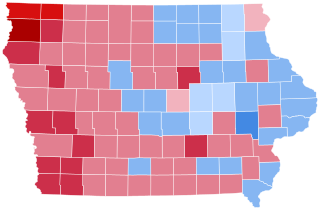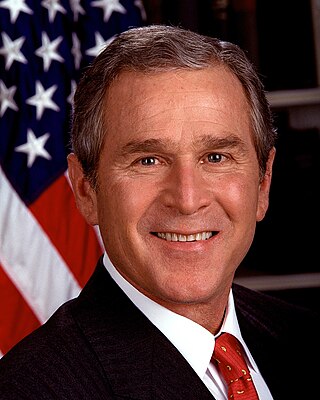
The 1912 United States presidential election was the 32nd quadrennial presidential election, held on Tuesday, November 5, 1912. Democratic Governor Woodrow Wilson of New Jersey unseated incumbent Republican President William Howard Taft while defeating former President Theodore Roosevelt and Socialist Party nominee Eugene V. Debs.

The Iowa caucuses are biennial electoral events for members of the Democratic and Republican parties in the U.S. state of Iowa. Unlike primary elections in most other U.S. states, where registered voters go to polling places to cast ballots, Iowans instead gather at local caucus meetings to discuss and vote on the candidates. During both the presidential and midterm election seasons, registered Iowan voters vote in a per-precinct caucus for the party of which they are registered as a member. The caucuses are also held to select delegates to county conventions and party committees, among other party activities.

The 2004 United States presidential election in Iowa took place on November 2, 2004, as part of the 2004 United States presidential election in which all 50 states plus the District of Columbia participated. Voters chose seven electors to represent them in the Electoral College via a popular vote pitting incumbent Republican President George W. Bush and his running mate, Vice President Dick Cheney, against Democratic challenger and Senator from Massachusetts John F. Kerry and his running mate, Senator from North Carolina John Edwards. Six third parties were also on the ballot.

Clyde LaVerne Herring, an American Democratic politician who served as the 26th governor of Iowa, and then one of its U.S. senators, during the last part of the Great Depression and the first part of World War II.

George Allison Wilson was an American politician and lawyer. He was a United States Senator and 28th Governor of Iowa.

The 2000 Iowa Republican presidential caucuses took place on January 24, 2000. The Iowa Republican caucuses are an unofficial primary, with the delegates to the state convention selected proportionally via a straw poll. The Iowa caucuses marked the traditional formal start of the delegate selection process for the 2000 United States presidential election.

The 1884–85 United States Senate elections were held on various dates in various states, coinciding with the presidential election of 1884. As these U.S. Senate elections were prior to the ratification of the Seventeenth Amendment in 1913, senators were chosen by state legislatures. Senators were elected over a wide range of time throughout 1884 and 1885, and a seat may have been filled months late or remained vacant due to legislative deadlock. In these elections, terms were up for the senators in Class 3.

The 1932 United States Senate election in Iowa took place on November 8, 1932. Incumbent Republican Senator Smith Brookhart, a controversial progressive figure within the conservative Iowa Republican Party, was defeated in the June Republican primary by Henry A. Field. Field was in turn defeated in the general election by Democrat Louis Murphy. Brookhart also entered the general election as the candidate of the Progressive Party but finished a distant third.

The 1988 United States presidential election in Iowa took place on November 8, 1988, as part of the 1988 United States presidential election. Voters chose eight representatives, or electors to the Electoral College, who voted for president and vice president.

The 1938 United States Senate election in Iowa took place on November 8, 1938. Incumbent Democratic Senator Guy M. Gillette, who won a special election to complete the unexpired term of Richard Louis Murphy, won a full term in office by defeating Republican former Senator Lester J. Dickinson. Gillette and Dickinson had briefly served together in the final months of 1936.

The 1950 United States Senate election in Iowa took place on November 7, 1950. Incumbent Republican Senator Bourke B. Hickenlooper was re-elected to a second term in office over Democratic U.S. Undersecertary of Agriculture Albert J. Loveland.

The 1978 Iowa gubernatorial election was held on November 7, 1978. Incumbent Republican Robert D. Ray defeated Democratic nominee Jerome D. Fitzgerald with 58.32% of the vote. As of 2022, this was the last time Johnson County voted for the Republican candidate.

The 1942 Iowa gubernatorial election was held on November 3, 1942. Republican nominee Bourke B. Hickenlooper defeated Democratic nominee Nelson G. Kraschel with 62.75% of the vote.

The 1940 Iowa gubernatorial election was held on November 5, 1940. Incumbent Republican George A. Wilson defeated Democratic nominee John K. Valentine with 52.72% of the vote.

The 1936 Iowa gubernatorial election was held on November 3, 1936. Democratic nominee Nelson G. Kraschel narrowly defeated Republican nominee George A. Wilson with 48.56% of the vote.

The 1934 Iowa State Senate elections took place as part of the biennial 1934 United States elections. Iowa voters elected state senators in 22 of the state senate's 50 districts. State senators serve four-year terms in the Iowa State Senate.

The 1932 Iowa Senate elections took place as part of the biennial 1932 United States elections. Iowa voters elected state senators in 30 of the senate's 50 districts. State senators serve four-year terms in the Iowa Senate.

The 1914 Iowa gubernatorial election was held on November 3, 1914. Incumbent Republican George W. Clarke defeated Democratic nominee John Taylor Hamilton with 49.31% of the vote.

The 1912 Iowa gubernatorial election was held on November 5, 1912. Republican nominee George W. Clarke defeated Democratic nominee Edward G. Dunn with 39.93% of the vote.

A general election was held in the U.S. state of Wyoming on Tuesday, November 7, 1950. All of the state's executive officers—the governor, secretary of state, auditor, treasurer, and superintendent of public instruction—were up for election. The Republican Party swept all of the offices. Following Democratic governor Lester C. Hunt's election to the U.S. Senate in 1948, Republican secretary of state Arthur G. Crane had been acting as governor. Republican Congressman Frank A. Barrett was elected governor, and Republican candidates won the other statewide races.



















